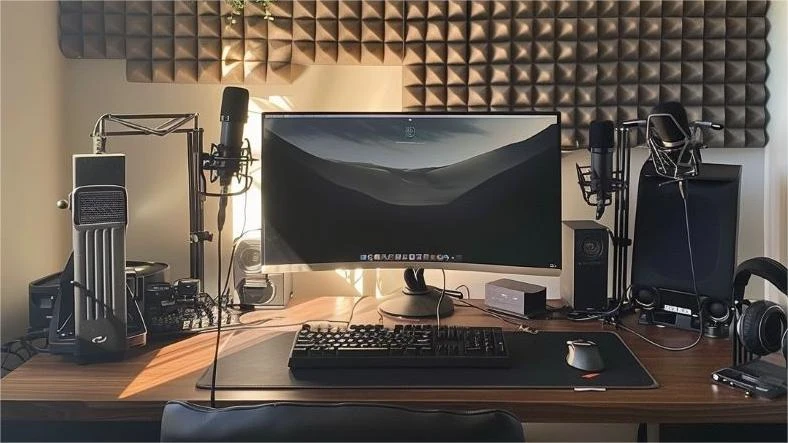Thanks to the ever-evolving technology, PCs are getting smaller and more powerful at the same time. A thin laptop or a small form factor PC can now do tasks that once required a large desktop computer.
Generally speaking, there are two types of SFF PCs: actively cooled mini PCs and fanless mini PCs. As consumers, it’s important for us to understand the pros and cons of those two types of mini PCs so that we end up purchasing the right unit.
What Are Fanless Mini PCs?
Fanless mini PCs, in contrast to actively cooled ones, are small form factor PC systems that don’t utilize rotating fans for cooling. Some basic fanless mini PCs solely rely on the perforated housing for passive heat dissipation, while higher-end models may come with effectively heat sinks like thermally conductive metal to transport the produced heat to the outside via lamellar cooling fins on the chassis of the computer.
Even though fanless systems are still the minority in the entire mini PC category, you can find a few models with decent sales numbers and positive customer reviews. Many buyers use it to deal with basic everyday tasks such as web-browsing, media playback, word processing, and spreadsheeting.
Fanless Mini PCs vs. Actively Cooled Mini PCs
Fanless mini PCs may have a few advantages over their fan-powered counterparts, but they also have some drawbacks. Here, we analyze the differences between these two types of systems by the following standards:
Performance
Mini PCs typically use mobile processors, instead of desktop-grade CPUs. However, even among mobile chips, the differences in performance can still be quite huge. Since passive cooling is not as efficient as actively cooling, fanless mini PCs usually sport processors with lower TDP to prevent the system from overheating.
For instance, the Pentium N5100 chip featured in the ASUS PN41 is only rated 6 watts. Although this mini PC tackles lightweight computing duties fairly well, it will struggle with heavier tasks. Actively cooled mini PCs, on the other hand, can feature CPUs with much higher TDP, which in return means greatly improved performance. The GEEKOM Mini IT11, for example, is powered by a 28W Intel Tiger Lake Core i7-1195G7 processor. Not only will it breeze through our everyday basics, but it is also able to handle more demanding duties.
Stability
Overheating can have a series of effects on a mini PC, and none of them is good. First, the electrical resistance of the internal components will drop, leading more electricity to flow through these components than originally designed. This will in return produce even more heat and possibly fry the component. Secondly, the platters making up the computer’s memory sticks and SSDs tend to expand when there’s too much heat, causing the data transfer speed to slow down, and in some worse cases, data loss and even permanent damages to the system. Third, excessive heat can cause the solder binding the components onto the motherboard to melt, resulting in parts’ falling off and eventually system failure.
With rotating fans actively exhausting hot air within the chassis, a fan-powered mini PC can stay cool more effectively than a passively cooled fanless mini PC, especially when its processor is under heavy workloads. Therefore, it is also more stable than the latter.
Portability
Since fanless mini PCs don’t need to reserve the room for cooling fans in the housing, they are generally smaller than actively cooled mini PCs. The MeLE Quiter3Q, for instance, measures only about the size of a smartphone. You can carry it around in your pocket effortlessly, making it more portable than any actively cooled mini PC you can find in the market.
Noise
One of the major benefits of fanless mini PCs is that they tend to run silently or near silently, thanks to the absence of rotating fans and the usage of noise-free solid-state drives. As a result, they are ideal for places where silent operation is needed, such as libraries, hospitals, recording studios, and small conference rooms. Fan-powered systems, on the other hand, will often produce audible noise, which can be a problem in certain areas.
Energy Efficiency
Many people tend to believe that fanless mini PCs are more power-efficient than actively cooled systems as they use lower-power CPUs, but that’s nothing but a misconception. The power draw of a PC system is not fixed, instead, it is constantly fluctuating according to the data being processed by the CPU and other components. Mini PCs with active cooling fans often draw as little power as units without fans when dealing with the same lightweight tasks. For instance, the GEEKOM Mini IT11 draws around 12 watts when playing a 4K video clip, that’s the same amount of power the fanless MeLE Quiter3Q mini PC needs when performing the same task.
Price
Fanless mini PCs are often quite cheap, but that doesn’t mean they offer better investment value. Most fanless mini PCs are priced quite low because they feature low-cost components such as basic Intel Atom-based CPUs and SATA3 standard SSDs. Actively cooled mini PCs, on the other hand, often come with premium CPUs and high-speed PCIe NVMe SSDs. With that said, you can also find plenty of fan-powered mini PCs that are even more affordable than their fanless counterparts. For example, the GEEKOM MiniAir 11 ($229) features a capable Intel Celeron N5105 quad-core processor, 8GB DDR4 memory, and 256GB SSD. It is 20% cheaper than the MeLE Quiter3Q ($270), which offers the same specifications.
Verdict: Are Fanless Mini PC Worth Buying?
With relatively low performance, fanless mini PCs are often designed to tackle basic computing tasks. Their silent operation makes them perfect for places where noise is less tolerable. For average consumers, a fanless mini PC can be used as a home file server, an HTPC, or a home office computer.
However, if your computing chores involve more than just everyday basics, you will be better off with an actively cooled mini PC as your daily driver, because the gain in performance and stability will make a huge difference in demanding duties such as complex graphics design, video editing, and intensive gaming.


















